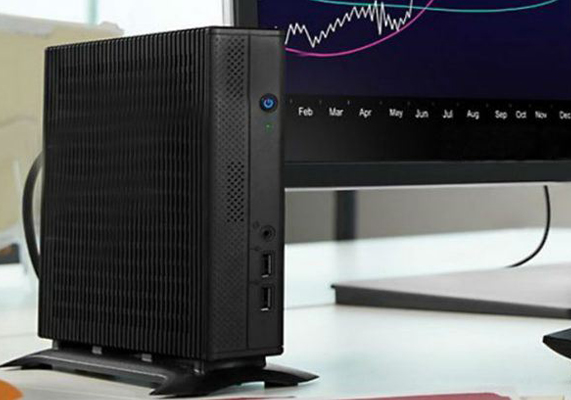The impact of cloud endpoint / Thin Client on the environment – Earth Day 2023
As endpoint specialists, we cannot afford not to think about the effects on the planet of the product that is at the core of our offer. We have taken the opportunity of Earth Day to discuss in this article the environmental impact of the endpoint we use to connect to access our virtual workspace.
Such a simple, everyday action, yet with huge implications on natural resources, energy consumption, gas emission, and natural landscapes. Today more than ever, we need to think of alternatives to produce and work in different ways. Let’s see why.
How cloud computing and virtualization changed the game
Since the last 30 years, organizations have shifted to the digital era. With the rise of the Internet in the 90’s, organizations started by automating their processes and generalizing PC for their users, before changing their business model and their operations. The acceleration of technological innovations, particularly the rise of cloud computing (private cloud, SaaS, PaaS, DaaS, IaaS, etc.) has multiplied the opportunities for organizations. The 2010 crisis and the recent Covid19 pandemic have shown that the adoption of cloud technologies is mandatory for an organization’s performance and stability. The figures are impressive:
- 85% of companies claim remote work has improved their productivity
- 65% of American workers work remotely at least one day per week
- 60% of the world’s company data is hosted in the cloud
- 200 zettabytes of data will be in the cloud in 2025
In a world where resources are more and more limited, how sustainable is this perpetual growth? Do we have the resources to lead this transformation without destroying the planet?
Cloud computing and VDI (Virtual Desktop Infrastructure) means resource pooling, since they take advantage of unused resources on servers to run several machines, operating systems, or organizational units on the same resource pool. The use of public clouds has also enabled many companies around the world for cost-effective and energy-intensive investments. Amazon Web Services, the world leader in cloud hosting, was born from the very pragmatic observation that Amazon’s servers were underutilized almost in the entire year (except in November and December).
Virtualization and cloud help reduce carbon footprint in many aspects:
- By reducing the technical interventions for troubleshooting/maintenance, thanks to centralized management,
- By enabling dematerialization,
- And most importantly by enabling remote working, thus reducing millions of people commuting every day. In May 2020, during the complete lockdown, Paris saw a decrease of almost 45% in its atmospheric level of nitrogen dioxide, a highly polluting component due to exhaust pipes. No doubt that remote work during the lockdown has played an important part in this decrease.
And yet, what digital transformation produces on one side, it destroys on the other. Today, nearly 4,800 data centers hosting our data around the world account for nearly 2% of global carbon emissions, a figure comparable to global air travel emissions. Operating 24/7 and therefore at risk of overheating, data centers require costly water-based air conditioning and cooling systems. A single datacenter requires 600,000 cubic meters of water per year, or 6.5 Olympic-sized swimming pools per day…
This paradox of the cloud that saves and wastes resources at the same time can also be found on the endpoints, through which we access the famous “cloud data”.
What is the impact of the cloud endpoint on the environment?
As the ultimate workstation, the PC has been growing steadily since Microsoft launched its first Windows PCs in the 1990s. However, it is far from being perfectly adapted to the new uses of the cloud, especially when compared to its eternal rival, the Thin Client.
Because a Thin Client only acts as a monitor, displaying data received from the cloud, it is less harmful to the environment than the PC. The reasons for this include:
- A very low resource consumption: on average between 800 and 1400 MWh per year versus 3000 to 4500 MWh for a PC. This difference is even greater when it comes to resource-intensive applications.
- Very little maintenance or updates are required, especially in terms of security. You also have the possibility to manage several Thin Clients at the same time, just as you manage a single Thin Client, resulting in time, money, and energy savings.
- An extended lifespan, sometimes more than 10 years, versus an average of 5 years for a PC. This extended lifespan reduces the renewal cycles of new hardware, resulting in less components (plastic waste, chemicals, metal parts) being recycled or abandoned in the nature.
This last point is crucial. Today, the production of hardware in unprecedented volumes and at unprecedented rates raises many questions. It is true that Thin Clients have fewer components than a PC: no fan, a smaller SSD and memory card, smaller overall size…
However, it cannot be denied that the electronics industry as a whole has a considerable impact on the environment. The use of scarce natural resources (lithium, cadmium, mercury…) doomed to depletion, the discharge of toxic water and components into nature, causing considerable damage to flora and fauna, the operation of factories often based on coal, the transportation of components around the world on large cargo ships polluting the air and the sea… The list of environmental impacts caused by the manufacturing of servers, PCs, tablets, and other Thin Clients is alarming.
Yet solutions exist to take advantage of what we already have, sometimes in abundance, instead of producing more and more.
The best endpoint to access your virtual workspace is the one you already have.
While electronics manufacturers have long tried to make us buy more and more through planned obsolescence, our existing PCs may hold unimagined resources. Too many companies think that modernizing their workstations necessarily involves a complete renewal of the hardware, whereas it is absolutely possible to:
- Upgrade your OS / virtualization platform,
- Increase endpoint security,
- Add additional functionalities such as multi-screen or touchscreen calibration,
- Switch to a centralized administration mode,
- Include support for new devices,
- Optimize printing and scanning processes…
While keeping the exact same hardware.
We are proud to have developed ZeeTransformer, which allows you to quickly convert your PCs into more energy-efficient, easier-to-manage, and longer-lasting endpoints in just 15 mins.
ZeeTransformer’s extremely versatile and customizable OS makes it suitable for almost any situation. We are working hard to support ever-growing range of manufacturers, models, platforms, and use cases.
So, if you already have PCs and are convinced by the value of moving to Thin Clients, you don’t necessarily have to buy new hardware. Moreover, Thin Client software technologies evolve much faster than hardware features. If you have an older Thin Client fleet that still performs well in hardware, but needs a software upgrade, ZeeTransformer allows you to switch to a more resource-efficient, high-performance, and secure operating system, with a management console that simplifies the work of your administrators.
We provide 10 free licenses to test ZeeTransformer. The licenses are yours to keep. Rest assured there are no hidden policies/obligations.

Search
Recent posts
- The main Cybersecurity risks of remote work: Safeguarding your infrastructure in a connected world 3 April 2024
- Introducing the latest version of ZeeScan! 22 February 2024
- Chromebooks in Business: Advantages and Challenges to Consider 19 February 2024
- Happy New Year from all of us at ZeeTim! 1 January 2024
- ZeeTim’s 2023 recap: Elevating end-user computing excellence 26 December 2023




